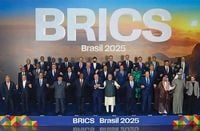In a world increasingly defined by shifting alliances and economic power plays, the BRICS bloc—once dismissed as a loosely organized group of emerging economies—has stepped onto the global stage with newfound assertiveness. The events of 2025, marked by the group’s rapid expansion and a bold response to escalating U.S. trade pressures, have signaled a profound transformation in the international order, with ripple effects that could shape global governance for years to come.
The story begins at the October 2024 Kazan summit, where BRICS—originally comprised of Brazil, Russia, India, China, and South Africa—unveiled a two-tiered membership system to manage its swelling ranks. By January 2025, the organization had welcomed Egypt, Ethiopia, Iran, the United Arab Emirates, Saudi Arabia, and Indonesia as full members, swelling its numbers to eleven and representing over 45% of the world’s population and nearly 30% of global GDP, according to reporting from Watcher.Guru and DotDotNews.
This new structure distinguishes between full members, who wield voting rights and full decision-making authority, and partner countries—Belarus, Bolivia, Cuba, Kazakhstan, Malaysia, Thailand, Uganda, and Uzbekistan—who may participate in projects but lack a say in the bloc’s final decisions. As Watcher.Guru explains, partner status serves as a "probationary period," offering a structured pathway to eventual full membership while ensuring the organization’s operational efficiency isn’t swamped by rapid expansion.
Full BRICS members enjoy comprehensive participation rights, from annual summits to Foreign Ministers’ meetings, and share equal stakes in the New Development Bank (NDB), which boasts $100 billion in authorized capital. Critical decisions, such as admitting new members, require unanimous consent—meaning any single nation can effectively veto expansion plans. This mechanism, while safeguarding cohesion, has also surfaced as both a strength and a challenge, especially as internal dynamics grow more complex.
Amid this backdrop of organizational change, external pressures have tested the bloc’s unity. On August 6, 2025, Brazilian President Luiz Inácio Lula da Silva issued a clarion call for a coordinated BRICS response to the latest volley of U.S. tariffs. President Donald Trump’s administration had slapped a punishing 50% tariff on Brazilian and Indian goods, tying it to demands such as halting prosecutions of former Brazilian leader Jair Bolsonaro. Lula, rejecting the notion of direct negotiations with Trump as "humiliating," instead announced plans to forge a joint strategy with Indian Prime Minister Narendra Modi and Chinese President Xi Jinping, as reported by DotDotNews.
"There is no coordination among the BRICS yet, but there will be," Lula declared, emphasizing the need for collective strength. His words underscored a growing sense of political cohesion within BRICS—a bloc that, since its founding in 2009, has steadily evolved from a loose economic coalition into a force capable of challenging U.S. dominance in global affairs.
This assertiveness is not just rhetorical. BRICS is actively preparing a suite of countermeasures designed to blunt the impact of U.S. economic pressure. Among these are efforts to accelerate local currency settlements in bilateral trade, thereby reducing reliance on the U.S. dollar. Initiatives such as Russia’s ruble-based payments and China’s push for internationalizing the yuan are already underway. The NDB, established in 2015, has become a viable alternative to Western-dominated financial institutions, and the 2025 Rio Summit saw the announcement of the BRICS Bridge payment platform—a direct competitor to the U.S.-controlled SWIFT system.
Additionally, the bloc is considering a coordinated challenge at the World Trade Organization (WTO) against the U.S. tariffs—a move that could expose Washington’s trade policies to international scrutiny. As DotDotNews notes, these steps have the potential to undermine the U.S. dollar’s dominance, raise American borrowing costs, and erode U.S. geopolitical leverage, potentially shaving trillions off its economic influence over time.
The expansion strategy itself reflects deeper geopolitical tensions. Russia and China, both facing exclusion from Western financial systems—especially after the 2022 Russian invasion of Ukraine—have been at the forefront of BRICS’ aggressive expansion. They view the bloc as a counterweight to Western institutions and a vehicle for advancing their own geopolitical ambitions. Conversely, India and Brazil have adopted a more cautious approach, wary of Chinese dominance and mindful of their own ties to the United States. As Watcher.Guru reports, India, in particular, sees BRICS as a tool for neutrality rather than an explicitly anti-Western alliance, and internal tensions have sometimes complicated expansion efforts.
Still, the momentum toward a more unified and assertive BRICS is unmistakable. The 2025 presidency under Lula has placed a spotlight on multilateralism and collective action, with a focus on reforms to global institutions such as the United Nations and the International Monetary Fund. The group’s push for a blockchain-based payment system and the development of alternatives to the SWIFT network are more than tactical maneuvers—they are part of a broader strategy to build resilience against unilateral economic pressure and to promote a multipolar world order.
U.S. policymakers, according to DotDotNews, have historically underestimated the bloc’s potential, often viewing it as a collection of disparate economies with conflicting interests—especially given India’s participation in U.S.-aligned initiatives like the Quad. But the recent U.S. tariffs, rather than sowing discord, have instead galvanized BRICS around shared grievances, such as sanctions on Russia and Iran, and have accelerated the bloc’s drive toward de-dollarization and alternative trade systems.
The distinction between full members and partner countries remains a crucial element of BRICS’ expansion model. While partner status does not confer voting rights, it allows prospective members to demonstrate alignment with the bloc’s objectives, paving the way for future integration. This model, balancing inclusive growth with organizational effectiveness, will be tested as the bloc continues to navigate internal tensions and external challenges.
As the world watches, the message from BRICS is clear: the era of unchallenged U.S. supremacy is fading. The bloc’s institution-building efforts, expanded economic weight, and willingness to confront unilateral actions collectively mark a pivotal moment in global geopolitics. Whether this signals the dawn of a truly multipolar order remains to be seen, but one thing is certain—the ground beneath the old world order is shifting, and BRICS is determined to play a central role in shaping what comes next.



